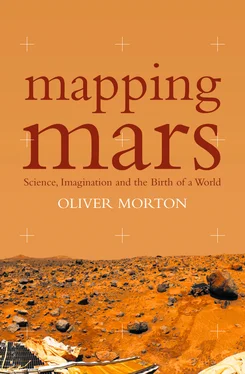Mars Observer was to sort all this out with an on-board radar system developed by a team at NASA’s Goddard Space Flight Center led by David Smith, a British geophysicist. Smith is a warm, affably excited man who, had he stayed in his native country, would be endlessly returning the smiles of women struck by his resemblance to the widely adored sportscaster Des Lynam. He had spent the 1970s applying the geophysical ideas attendant upon plate tectonics to studies of the shape of the earth, and he was excited about moving on to other planets shaped by other processes. Then, in late 1986, the shuttle struck again. Mars Observer had been scheduled for launch in 1990, but after the Challenger disaster the risk of the shuttle’s schedule slipping convinced NASA officials to delay the launch until the next time the planets were correctly aligned, two years later. Delaying by two years meant that the spacecraft’s costs went up, because it was not feasible simply to disband the teams already at work. Savings had to be made and so the two heaviest instruments were dropped. One was the radar.
David Smith was not going to give up. He convinced NASA to put $10 million on the table to produce a replacement instrument and, having looked at a couple of radars, decided to use a new, much less tested technology, one that bounced laser light off the surface instead of radio waves. People in Smith’s group at Goddard were already working on such an altimeter for the proposed Lunar Observer; a modified version became a relatively cheap altimeter for the Mars Observer. There were risks involved – no laser system had ever survived in space remotely as long as this one would have to – and the development was a little hairy in places. But they got the instrument finished on time and in budget. That was more than could be said for the rest of the mission. Partly due to the delays, Mars Observer’s costs rocketed – the notional later Observers were cancelled as a result. Then it was decided to launch on an expendable rocket rather than a shuttle, adding yet more to the expense. * Then a hurricane hit the rocket while it was on the pad at Canaveral. Finally, on 25 September 1992, with the Mars Observer Laser Altimeter (MOLA) safely on board, Mars Observer got off the ground. And eleven months later, having been told to pressurise its fuel tanks in preparation for going into orbit around Mars, the spacecraft fell silent, never to be heard from again. It is more or less universally assumed to have exploded.
It was a terrible blow. Back when Mars missions were sent out two at a time, losing one was OK; Mariner 3 was lost, part of Mariner 7 exploded, Mariner 8 was lost, but Mariners 4, 6 and 9 did just fine. Mars Observer, though, was a singleton and the designers of its nine scientific instruments were bereft. Smith told me that while imagining ways in which the MOLA instrument itself might fail had come all too easily to him, he’d never imagined the whole spacecraft being lost. NASA’s administrator, though – a bullying, obstreperous but undeniably dynamic and often perceptive man named Dan Goldin – decided the loss was an opportunity. Goldin was sick of being responsible for the sort of space programme that launched only a couple of planetary spacecraft every decade and was determined to find ways of sending out more missions – ‘faster, better, cheaper’ missions, as he delighted in calling them. The first faster, better, cheaper programme, called Discovery, was to send spacecraft all over the solar system. Indeed, the second Discovery mission, due to take off in late 1996, was a Mars lander – Mars Pathfinder. (Mars Pathfinder was actually conceived before the Discovery programme; as its name implies, it was meant to be the first in a series of simple landers. The series of simple landers was cancelled and Pathfinder, like Mars Observer, became a one-off, * slotted into the Discovery programme for more or less purely political reasons.) Goldin and his advisers at NASA headquarters decided that a second line of faster-better-cheaper spacecraft should be devoted to Mars. In order to spur new thinking and greater efficiency, the size of the spacecraft and the budgets in this Mars Surveyor programme were to be tightly constrained.
The first of the missions was Mars Global Surveyor (MGS) and it has proved massively successful. Launched in November 1996, it arrived at Mars a few months after Mars Pathfinder’s landing on 4 July 1997. MGS carried copies of five of Mars Observer’s instruments, for the most part cobbled together out of spare parts. Soon after arriving it started a long series of passes through the thin upper atmosphere, a way of losing energy to make its orbit shorter and more circular. This technique, ‘aerobraking’, was new and somewhat risky. In the old days before faster-better-cheaper, changing orbits was something you did with engines, not drag. But drag is free and engines cost money.
In the end this aerobraking took a lot longer than anticipated: most of the atmospheric drag was felt by MGS’s solar panels and the arm holding one of these panels turned out to have a flaw in it. The aerobraking sequence was modified so that the spacecraft dipped into the atmosphere even less than had been planned, the force exerted on it ending up as less than three newtons – about the force it takes to lift a Big Mac. This slowed things down and it was not until early 1999 that MGS reached its final orbit, circling the planet every two hours or so, about 400 kilometres above the surface. The instruments now got down to business. The infrared spectrometer scanned the surface to see what minerals were present, and where. The camera, capable of picking out features just a couple of metres across, started adding long, thin tracks of extraordinary and frequently confusing new details to the coarser pictures of the Mariners and Vikings. And MOLA’s laser gently zapped the surface beneath the spacecraft ten times a second. The laser beam would illuminate a patch of Mars about 160 metres across and the altimeter’s clock would measure the time it took the light to get mere and bounce back (less than three thousandths of a second). The exact length of time revealed how high up the spacecraft was. Combine that altitude with tracking data showing where the spacecraft was – the tracking on MGS was exquisite – and you get a point in a global altimetry database. By the middle of April MOLA had produced almost 27 million such altitude measurements. For the most part they were precise to within less than a metre, which means that two nearby spots which seemed to have the same altitude would in reality be no more than a metre different in elevation. The overall accuracy with which the MOLA measurements determined the global shape of Mars was about eight metres.
A year after MGS reached its final orbit, in March 2000, planetary scientists from all over America and much of the rest of the world gathered in Houston for the Lunar and Planetary Science Conference, just as they have done every year since 1970, when the first such conference pored over studies of the first samples returned from the moon. For a week, the Johnson Space Center’s recreation building was turned over to them, and its basketball courts rang to the announcement of more and more news from Mars. At least a hundred papers on Mars were presented, most of them informed by MGS data in one way or another. To many of those attending, Mars seemed to be changing before their eyes. MGS measurements were discovering new features and forcing the reinterpretation of old ones. The idea that there had once been an ocean on Mars was starting to gain serious respectability. So was the idea that, far from having been geologically dead for billions of years, Mars was in fact still active. The old familiar face of the planet was taking on a youthful cast in the new light. The scientists were as reinvigorated as their planet.
Читать дальше












